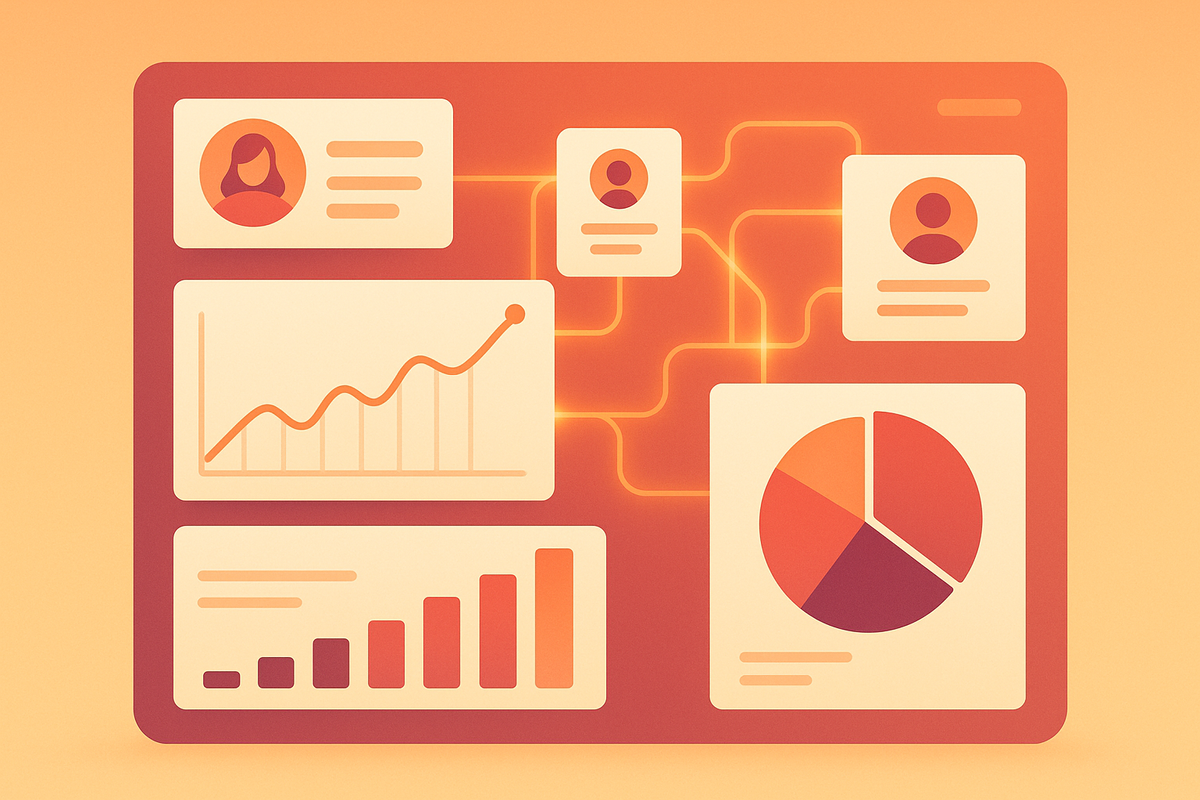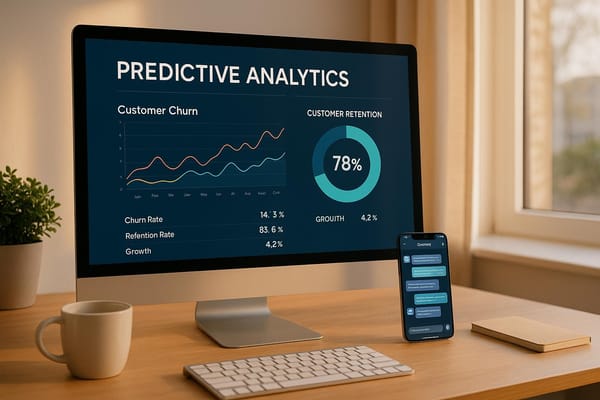How to Use Customer Data for Churn Prediction
Leverage customer data effectively to predict churn and implement strategies that enhance retention and strengthen customer relationships.

Want to keep your customers from leaving? The key is using customer data to predict churn and take action before it happens. Here's how:
- Track customer behavior: Look at purchase patterns, engagement levels, and support interactions.
- Spot warning signs: Sudden drops in usage, unresolved support issues, or payment changes could signal churn.
- Use tools like HelpJam: Centralize and analyze data from support tickets, live chat, and feature usage.
- Apply machine learning models: From simple Logistic Regression to advanced Gradient Boosting, choose the right model to predict churn.
- Act on insights: Offer proactive support, personalized engagement, and improved resources to retain high-risk customers.
Finding and Gathering Customer Data
Predicting churn accurately starts with collecting the right customer data in an organized way.
Main Data Types for Churn Analysis
Here are the key categories of customer data to focus on for churn prediction:
Purchase and Transaction Data
- Frequency and value of purchases
- Average order size
- Time gaps between purchases
- Payment history
- Changes in subscription status
Engagement Metrics
- How often the product is used
- Adoption rates of specific features
- Time spent on the product
- Login patterns
- Overall account activity
Support Interaction Data
- Number of support tickets
- Time taken to resolve issues
- Customer satisfaction ratings
- Commonly reported problems
- Response times
- Preferred support channels
Customer Demographics
- Industry or business type
- Company size
- Geographic location
- Duration of account activity
- Contract terms
Behavioral Indicators
- Trends in feature usage
- Preferred communication methods
- Views of knowledge base articles
- Engagement with live chat
- Email response rates
Once you identify the data you need, it’s essential to use effective methods to gather it.
Data Collection Methods
Use these strategies to collect customer data while adhering to US privacy laws:
Centralized Data Collection
Tools like HelpJam make it easier to centralize data through:
- Help desk ticket tracking
- Monitoring live chat interactions
- Analyzing knowledge base usage
- Running customer satisfaction surveys
- Tracking real-time engagement
Integration Strategy
Build a seamless data collection system by:
- Linking your CRM with support tools
- Using API integrations to sync data
- Adding tracking codes to your website
- Setting up webhooks for live updates
- Automating data pipelines for efficiency
Data Privacy Compliance
Handle customer data responsibly by:
- Following CCPA regulations
- Encrypting data and maintaining clear privacy policies
- Obtaining customer consent
- Conducting regular security audits
Consistency, accuracy, and respect for privacy are the cornerstones of effective data collection. With these methods, you’ll create a strong foundation for analyzing churn.
Data Preparation Steps
Getting your data ready is crucial for accurate churn prediction. Clean, consistent, and standardized data helps ensure reliable insights and better prediction results. Start by organizing and standardizing your data formats.
Data Cleanup and Format Rules
Standardize Date Formats
- Convert all dates to the US format (MM/DD/YYYY).
- Use 12-hour timestamps with AM/PM indicators.
- Align all timestamps to the same time zone, preferably EST/EDT for US-based operations.
Normalize Number Formats
- Use decimal points for fractions (e.g., 3.14, not 3,14).
- Add the USD symbol ($) to currency values.
- Include thousand separators (e.g., 1,000,000).
- Round currency values to two decimal places for consistency.
Fill Missing Data
- Deploy AI chatbots to gather missing details during customer interactions.
- Set up systems for real-time data collection, like browser details and location.
- Make critical fields - such as email and name - mandatory during data entry.
Creating Useful Data Points
Transform raw data into actionable metrics that can indicate potential churn.
Customer Value Metrics
- Monthly Recurring Revenue (MRR) per customer.
- Customer Lifetime Value (CLV).
- Average purchase frequency.
- Total support costs associated with each customer.
Engagement Indicators
- Frequency of product usage.
- Rates of feature adoption.
- Time taken to resolve support tickets.
- Views of knowledge base articles.
| Metric Type | Calculation Method | Churn Signal Threshold |
|---|---|---|
| Usage Score | (Daily logins × Feature interactions) ÷ 30 | Below 0.3 |
| Support Health | (Resolved tickets ÷ Total tickets) × Response speed | Below 0.7 |
| Value Risk | (Current month MRR ÷ Highest MRR) × 100 | Below 60% |
Custom Data Fields
- Date of the last meaningful interaction.
- Trends in feature usage over time.
- Customer satisfaction with support services.
- Patterns in payment history.
- Overall account health indicators.
Setting Up Churn Prediction Models
Machine learning turns customer data into churn predictions that can guide your business decisions. Choosing the right model depends on your data and specific needs.
Types of ML Models
Each type of model offers different strengths for churn analysis. Your selection should fit your data's complexity and what you aim to achieve.
Logistic Regression
This model highlights straightforward churn signals, like a drop in usage or an increase in support tickets.
Random Forest
Handles multiple data points - such as usage frequency, support tickets, payment history, and feature adoption - to uncover complex patterns.
Gradient Boosting
Builds on earlier predictions to improve accuracy over time. It's especially good at spotting subtle behavioral changes that might hint at churn.
| Model Type | Best Use Case | Data Requirements | Implementation Complexity |
|---|---|---|---|
| Logistic Regression | Simple predictions with clear signals | Basic customer metrics | Low |
| Random Forest | Detecting complex patterns | Multiple data points, historical data | Medium |
| Gradient Boosting | Tracking evolving behaviors | Large historical dataset | High |
Model Training Guide
Once you've picked a model, follow these steps to train and validate it for churn prediction.
Data Preparation
Use real-time customer data to create a reliable training set.
Training Process
-
Initial Data Split
Divide your data into 70% for training and 30% for testing. Ensure both churned and active customers are included. -
Feature Selection
Focus on critical features like engagement levels, support history, usage trends, and payment behaviors. -
Model Validation
Evaluate the model's performance using metrics like precision, recall, and the F1 Score. -
Continuous Refinement
Regularly monitor the model's performance and update it with fresh data to keep it effective.
Using Results to Stop Churn
Once you've built churn prediction models, the next step is turning those insights into actions that help retain customers.
Spotting High-Risk Customers
Keep an eye on these key signs that a customer might be at risk of leaving:
Engagement Patterns
Look for sudden drops in how often customers use your product, a decline in feature adoption, or less interaction with your platform overall.
Support Interactions
Pay attention to customers with repeated support issues or unresolved complaints.
By identifying these patterns, you can focus on the customers who need attention the most.
Strategies to Keep Customers Around
Leverage your predictions to create targeted plans that improve retention:
Proactive Support
Deploy AI chatbots or similar tools to provide instant help when customers need it.
Personalized Engagement
Tailor your outreach based on each customer's behavior and support history. Consider offering one-on-one walkthroughs to show them how to get the most out of your service.
Improved Resources
Expand and refine your knowledge base to address frequent customer questions and problems more effectively.
Measure how well these approaches work and adjust them based on clear performance data.
Measuring and Refining Retention Efforts
Use the following metrics to evaluate and enhance your retention strategies:
Response Performance
Track how quickly and effectively customer issues are resolved, along with satisfaction ratings.
Content Usage
Analyze which articles or resources in your knowledge base are helping customers the most, and update your content accordingly.
Retention Metrics
Focus on key data points like:
- Churn rate: Compare your predictions with actual churn numbers over time.
- Engagement gains: Check for increases in product usage after implementing retention efforts.
- Support efficiency: Monitor resolution times and customer satisfaction scores.
Utilizing tools like HelpJam's analytics dashboard can make it easier to track these metrics in real time and fine-tune your retention strategies on the go.
Conclusion
Predicting churn effectively hinges on careful management and analysis of customer data. By organizing and analyzing this data, businesses can take steps to improve retention rates.
Using the data collection methods discussed earlier, a strong churn prediction strategy relies on detailed data, accurate analysis, and quick responses. Tools like HelpJam make it easier to gather customer interaction data - spanning everything from support conversations to how customers use your knowledge base - giving a full view of engagement.
With AI-driven analytics and real-time monitoring, businesses can spot churn signals early. This allows support teams to address problems promptly and maintain solid customer relationships. These insights provide a strong foundation for ongoing improvements.
Modern tools make this process easier by offering features like:
- Real-time analytics to monitor customer engagement patterns
- AI-driven insights for quicker and smarter decisions
- Automated support systems to respond immediately to customer needs
- Detailed reporting to refine and optimize strategies
These tools support continuous refinement, which leads to measurable results.
As emphasized earlier, managing data effectively and leveraging real-time insights are essential. Scalable support solutions - ranging from basic features to advanced tools - enable companies to nurture lasting customer relationships. This not only improves retention but also boosts customer lifetime value, making it a worthwhile investment.
FAQs
How can businesses protect customer privacy while using data for churn prediction?
To ensure customer privacy while collecting and using data for churn prediction, businesses should follow key data protection principles. Obtain clear consent from customers before collecting their information, and be transparent about how the data will be used. Limit data collection to only what is necessary for churn prediction, such as purchase history or engagement metrics.
Additionally, comply with relevant privacy laws, such as the General Data Protection Regulation (GDPR) or the California Consumer Privacy Act (CCPA), depending on your business location and customer base. Use techniques like data anonymization or encryption to safeguard sensitive information. Regularly review and update your privacy policies to stay aligned with evolving regulations and customer expectations.
What are the main differences between Logistic Regression, Random Forest, and Gradient Boosting for predicting customer churn?
Logistic Regression, Random Forest, and Gradient Boosting are popular models for predicting customer churn, but they work differently and have unique advantages:
- Logistic Regression: This is a simple, interpretable model often used as a baseline. It works well when the relationship between features and churn likelihood is linear, but it may struggle with complex patterns.
- Random Forest: This model uses multiple decision trees to make predictions and is effective for handling large datasets with nonlinear relationships. It’s robust to overfitting, but it can be less interpretable compared to Logistic Regression.
- Gradient Boosting: Known for its high accuracy, Gradient Boosting builds trees sequentially to correct previous errors. It’s ideal for capturing intricate patterns in data but can be more computationally intensive.
Each model has its strengths, so the best choice depends on your data characteristics and business goals. For example, Logistic Regression is great for quick insights, while Gradient Boosting often delivers the most precise predictions for complex datasets.
How can businesses use churn prediction insights to boost customer retention?
To effectively act on churn prediction insights, businesses should focus on identifying at-risk customers and implementing targeted retention strategies. Start by analyzing key data points like purchase history, engagement levels, and support interactions to uncover patterns that indicate potential churn.
Once you've identified these customers, take proactive steps such as personalized outreach, offering tailored incentives, or addressing specific pain points to re-engage them. Additionally, leveraging tools like AI-powered analytics or customer support platforms can help streamline efforts and improve the overall customer experience. By acting quickly and strategically, businesses can reduce churn and foster long-term loyalty.





